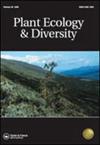Scarce fire activity in north and north-western Amazonian forests during the last 10,000 years
IF 1.6
4区 生物学
Q2 PLANT SCIENCES
引用次数: 13
Abstract
ABSTRACT Background Fire is known to affect forest biodiversity, carbon storage, and public health today; however, comparable fire histories from across forest regions in Amazonia are lacking. Consequently, the degree to which past fires could have preconditioned modern forest resilience to fire remains unknown. Aim We characterised the long-term (multi-millennial) fire history of forests in Amazonia to determine spatial and temporal differences in fire regimes. Methods We collated and standardised all available charcoal data extracted from continuously deposited lake sediments (n = 31) to reconstruct a ca. 10,000-year fire history for: (i) north and north-western, (ii) south-western, and (iii) eastern parts of Amazonia. Results Charcoal was found across Amazonia, but it was less abundant in the north and north-western regions. Regionally distinct periods of elevated charcoal deposition were identified at between ca. 4000 and 1500 (eastern), 3000–1000 (south-western) and 2500–2000 (north and north-western) years ago. Conclusions Forests in eastern and south-western Amazonia have been exposed to fire activity over recent millennia, while the forests in north and north-western Amazonia have grown under conditions largely free of fire activity. Consequently, we hypothesise that the forests in eastern and south-western Amazonia are preconditioned to be relatively more resilient to the threat of increased modern fire activity.过去10000年中亚马逊北部和西北部森林的可怕火灾活动
背景众所周知,如今火灾会影响森林生物多样性、碳储存和公众健康;然而,亚马逊地区各森林地区缺乏可比的火灾历史。因此,过去的火灾在多大程度上预处理了现代森林对火灾的恢复能力仍然未知。目的我们对亚马逊地区森林的长期(数千年)火灾历史进行了表征,以确定火灾状态的空间和时间差异。方法我们整理并标准化了从连续沉积的湖泊沉积物(n=31)中提取的所有可用木炭数据,以重建亚马逊地区约10000年的火灾历史:(i)北部和西北部,(ii)西南部和(iii)东部。结果木炭在整个亚马逊地区都有发现,但在北部和西北部地区含量较低。在约4000年至1500年(东部)、3000年至1000年(西南部)和2500年至2000年(北部和西北部)之间发现了不同区域的木炭沉积期。结论近千年来,亚马逊东部和西南部的森林一直暴露在火灾活动中,而亚马逊北部和西北部的森林是在基本上没有火灾活动的条件下生长的。因此,我们假设亚马逊东部和西南部的森林经过预处理,相对而言更能抵御现代火灾活动增加的威胁。
本文章由计算机程序翻译,如有差异,请以英文原文为准。
求助全文
约1分钟内获得全文
求助全文
来源期刊

Plant Ecology & Diversity
PLANT SCIENCES-
CiteScore
3.30
自引率
0.00%
发文量
26
审稿时长
3 months
期刊介绍:
Plant Ecology and Diversity is an international journal for communicating results and novel ideas in plant science, in print and on-line, six times a year. All areas of plant biology relating to ecology, evolution and diversity are of interest, including those which explicitly deal with today''s highly topical themes, such as biodiversity, conservation and global change. We consider submissions that address fundamental questions which are pertinent to contemporary plant science. Articles concerning extreme environments world-wide are particularly welcome.
Plant Ecology and Diversity considers for publication original research articles, short communications, reviews, and scientific correspondence that explore thought-provoking ideas.
To aid redressing ‘publication bias’ the journal is unique in reporting, in the form of short communications, ‘negative results’ and ‘repeat experiments’ that test ecological theories experimentally, in theoretically flawless and methodologically sound papers. Research reviews and method papers, are also encouraged.
Plant Ecology & Diversity publishes high-quality and topical research that demonstrates solid scholarship. As such, the journal does not publish purely descriptive papers. Submissions are required to focus on research topics that are broad in their scope and thus provide new insights and contribute to theory. The original research should address clear hypotheses that test theory or questions and offer new insights on topics of interest to an international readership.
 求助内容:
求助内容: 应助结果提醒方式:
应助结果提醒方式:


